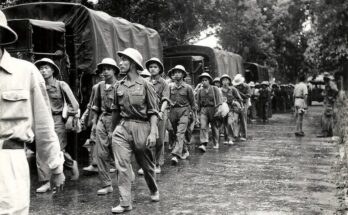Introduction
The Ottoman Empire was one of history’s most powerful and enduring empires, spanning over six centuries. At the heart of its military might stood the Janissary Corps, an elite infantry force that played a crucial role in the empire’s expansion and dominance. But who were these warriors? How did they rise to power, and what led to their eventual decline? Let’s dive into the fascinating history of the Janissaries, exploring their origins, structure, influence, and ultimate downfall.
The Origins of the Janissary Corps
The Devshirme System: Recruitment of Janissaries
The Janissary Corps originated in the 14th century under Sultan Murad I as part of the Devshirme system. This practice involved the forced recruitment of Christian boys from the Balkans, who were taken from their families, converted to Islam, and trained to serve the Ottoman state. While this may seem harsh, many of these boys rose to prominent positions in the empire.
A Unique Military Force
Unlike other military units of the time, the Janissaries were not mercenaries or feudal soldiers. Instead, they were a standing army, loyal only to the Sultan. This made them a formidable and reliable force, ensuring the empire’s stability and expansion.
The Structure and Training of the Janissaries
Strict Training and Discipline
Ottoman Empire’s Janissary Corps, Janissaries underwent rigorous training in military tactics, weapon handling, and discipline. They lived in barracks, followed strict rules, and were prohibited from marrying or engaging in trade. This monastic lifestyle ensured their undivided loyalty to the empire.
The Janissary Code
Janissaries adhered to a strict code of conduct known as the “Kanun.” This code emphasized loyalty, brotherhood, and military excellence. Any breach of discipline was met with severe punishment, reinforcing their reputation as an elite force.
The Role of Janissaries in the Ottoman Military
Masters of Firearms
One of the reasons for the Janissaries’ success was their early adoption of firearms. While many European armies still relied on traditional melee weapons, the Janissaries used muskets and artillery, giving them a significant advantage on the battlefield.
Key Battles and Campaigns
The Janissaries played a crucial role in numerous Ottoman victories, including:
- The Battle of Kosovo (1389): Securing Ottoman dominance in the Balkans.
- The Fall of Constantinople (1453): Leading the charge under Sultan Mehmed II.
- The Battle of Mohács (1526): Decimating the Hungarian army and expanding Ottoman influence in Central Europe.
The Political Influence of the Janissaries
From Soldiers to Power Brokers
Over time, the Janissaries gained significant political influence. They were not just soldiers; they became kingmakers, often deposing sultans and installing rulers who catered to their demands. This shift from military service to political maneuvering marked the beginning of their decline.
Corruption and Resistance to Reform
As the empire modernized, the Janissaries resisted change. They opposed military reforms that introduced modern tactics and weapons, fearing the loss of their privileged status. Their resistance to progress weakened the Ottoman military, making it vulnerable to European advancements.
The Downfall of the Janissary Corps
The Auspicious Incident (1826)
By the early 19th century, the Janissaries had become more of a burden than an asset. Their refusal to adopt new military strategies led Sultan Mahmud II to take drastic action. In 1826, he orchestrated the “Auspicious Incident,” in which the Janissaries were brutally suppressed and disbanded. Thousands were killed, and their barracks were burned to the ground, marking the end of the once-feared corps.
The Aftermath
With the dissolution of the Janissary Corps, the Ottoman Empire sought to modernize its military, adopting European-style tactics and organization. However, the damage had already been done. The empire continued to decline, eventually collapsing in the early 20th century.
The Legacy of the Janissaries
Cultural and Historical Impact
Despite their decline, the Janissaries left an indelible mark on history. They influenced military tactics, state governance, and even Ottoman culture. Their distinctive music, uniforms, and traditions continue to be studied and admired today.
Lessons from History
The rise and fall of the Janissary Corps serve as a powerful lesson on the dangers of unchecked power, resistance to reform, and the need for adaptability in a changing world.
The Ottoman Empire’s Naval Dominance: A Voyage Through History
Conclusion
The Janissary Corps was a unique and formidable force that shaped the Ottoman Empire’s destiny. From their humble beginnings as enslaved Christian boys to their rise as the empire’s elite warriors and eventual downfall, their story is one of ambition, power, and the consequences of stagnation. While they may no longer march in formation, their legacy continues to fascinate historians and military enthusiasts alike.
FAQs
1. Why were the Janissaries so feared?
The Janissaries were feared due to their elite training, discipline, and early use of firearms, which gave them an edge over their enemies.
2. What made the Janissaries unique compared to other military units?
Unlike feudal armies, the Janissaries were a professional standing force loyal to the Sultan, which ensured their reliability and effectiveness.
3. Did the Janissaries have any weaknesses?
Yes, their resistance to reform and growing political influence led to corruption, inefficiency, and ultimately their downfall.
4. How did the Devshirme system impact the Janissaries?
The Devshirme system provided the Janissaries with a steady supply of young recruits who were trained to be loyal and disciplined warriors.
5. What happened after the Janissaries were disbanded?
Following their dissolution in 1826, the Ottoman Empire modernized its military, but internal decline and external pressures continued to weaken it until its collapse in 1922.


